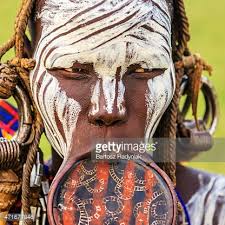Beauty Standards Around the World
In this blog I hope to cover different cultures and their beauty standards, I hope you find it both informative and interesting.
Saturday, 24 October 2015
Masai tribe, Kenya

In the Masai tribe, both men and women stretch their ears and they’re often decorated with beautiful bead work, matching that of their cartilage piercing. One documented way to stretch the earlobe is by using weight, the other is to insert things like tusk, wood and stone, gradually increasing the size of the item. It is most common for the elder members to have the largest piercings as they have been through the most stretching.
Mursi women, southern Ethiopia
 the Mursi women from southern Ethiopia use clay
or wood plates to stretch the bottom lip, each
woman crafts her own plate. A girl 6-12 months away from being married, usually
around the ages 16-18, will have her lip pierced by either her mother or one of
her kinswomen. Initially, the piercing is only 1-2cm wide and is held open with
a wooden peg, around 1-3 weeks later once the wound has healed, a slightly
larger peg is inserted. The first clay lip plate is inserted once the piercing
has a diameter of around 4 cm, the final diameter of the piercing is can vary anywhere from 8-20
cm.
the Mursi women from southern Ethiopia use clay
or wood plates to stretch the bottom lip, each
woman crafts her own plate. A girl 6-12 months away from being married, usually
around the ages 16-18, will have her lip pierced by either her mother or one of
her kinswomen. Initially, the piercing is only 1-2cm wide and is held open with
a wooden peg, around 1-3 weeks later once the wound has healed, a slightly
larger peg is inserted. The first clay lip plate is inserted once the piercing
has a diameter of around 4 cm, the final diameter of the piercing is can vary anywhere from 8-20
cm.
Karo tribe, Ethiopia
Body scarring is done throughout many different cultures, each for different reasons. The people of the Karo tribe scar both their men and women, men

scar
their chest as a way of representing those killed in rival tribes, and woman
scar parts of their torso as it is seen as beautiful and are used to mark
stages of a young girls life. A woman is allowed to marry once she has acquired
all of her scars, women with fashionable scars are viewed as being more
attractive.
The
scarring process is done using a sharp knife or glass to create precise shapes.
Once cut, the open wound is left to be treated with strong juices from plants or
charcoal. This is done to create a slight infection, which will result in the
healed wound being risen and dark. Ones scars can be used to tell a lot about
them such as their political role and social status.
Kayan Tribe, Thailand
 The Kayan tribe of Thailand wears brass rings around their
neck from the age of five and add more as they get older to stretch and
elongate their neck. This is done because in their culture, a super long neck
is seen as ideal and considered beautiful. The brass rings are actually long
coils of brass, and a full set of neck rings consist of three separate coils
all together weighing around 10 kg, few women wear this.Wearing
the rings has minimal impact on ones ability to move, and does not limit
wearers to few activities. In the process of neck stretching, the neck isn’t
actually being stretched, with the rings pushing down on the muscles around the
collar bone, it simply gives the appearance of a longer neck.
The Kayan tribe of Thailand wears brass rings around their
neck from the age of five and add more as they get older to stretch and
elongate their neck. This is done because in their culture, a super long neck
is seen as ideal and considered beautiful. The brass rings are actually long
coils of brass, and a full set of neck rings consist of three separate coils
all together weighing around 10 kg, few women wear this.Wearing
the rings has minimal impact on ones ability to move, and does not limit
wearers to few activities. In the process of neck stretching, the neck isn’t
actually being stretched, with the rings pushing down on the muscles around the
collar bone, it simply gives the appearance of a longer neck.
There
are many tales surrounding the origin and reason for the neck rings, many
following the themes of:
 • Wearing the rings was method used to
stop valuables being stolen by melting items and wearing them.
• Wearing the rings was method used to
stop valuables being stolen by melting items and wearing them.
• They were a way of being identified, to prevent the chance of being taken by another tribe.
• The rings are symbol of being a decedent of the dragon ‘she’.
• They’re worn for beauty purposes.
Subscribe to:
Comments (Atom)




